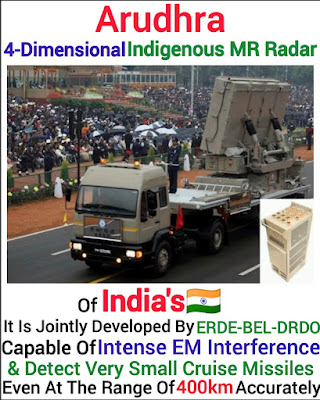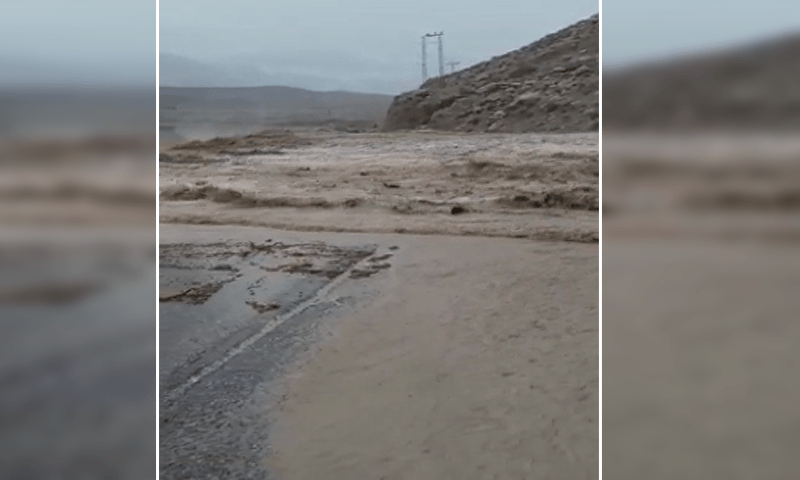DRDO/BEL ARUDHRA : India’s 4D Medium Power Radar
Arudhra is a Medium Power Radar (MPR) developed by Electronics and Radar Development Establishment. The MPR features a rotating active phased array antenna with solid state transceiver modules operating in S-band (2-4GHz).
Performance metrics of Arudhra MPR
Arudhra is capable of tracking a small fighter sized target (Radar Cross Section of 2 sqm) as far as 300km at an altitude between 100 meters to 30 km. Azimuth and elevation coverage depends on the mode of operation. Arudhra can operate in:
Rotation mode – In rotation mode, antenna rotates at 7.5/15 rounds per minute (RPM) covering 360 degrees in azimuth and 30 degrees in elevation.
Staring mode – In staring, antenna remains and target airspace is scanned by electronic beam steering. Desired coverage is attained by using multiple wide scanning beams
In tracking mode, Arudhra’s elevation is increased to 50 degrees making it capable of tracking rockets and artillery projectiles. Targets are automatically detected and resolved in 4 dimensions (4-D) namely Range, Azimuth, Height, and Doppler velocity.
Arudhra radar has a cross pattern of 5 beams in azimuth and elevation, means that 5 beams independently scan the surrounding airspace sideways and up and down ways to locate the target, one targets are located they are tracked while still more targets are searched. The coverage is attained using wide transmit beam and multiple receive beams in both azimuth and elevation.
The system is able to survive intense ECM environment and possible electromagnetic interference. Arudhra is fully programmable from the local Operator Work Station and from remote Operator Work Station Unit. Arudhra being a 4D radar can determine range (straight distance from radar), azimuth (angular position from a reference direction), altitude (distance from ground) as well as velocity vector (representation of direction of motion) of a target.
The most important capability of Arudhra is it can detect small targets such as cruise missiles at very long range which makes it particularly useful on the western border. The radar can detect targets with radar cross section (RCS) of 0.2 sqm as far as 160 km. Cruise missiles such as Babur, Ra’ad and Tomahawk have RCS of 0.5 sqm. If stationed at strategic locations and fully integrated with IACCS, Arudhra radars will make it harder for hostile cruise missiles to get through the defensive net. The radar can remain operational in intense jamming and interference. It is likely that radar’s electronic components were hardened to survive Electromagnetic Pulse (EMP) resulting from a tactical nuclear detonation- a possible scenario for a war fought along the western frontier.
In short :
Range: 400 km (maximum)
Detection range for 2sqm RCS target: 300km
Detection range for LO target (0.2 sqm RCS) : 160km
Coverage (surveillance- rotation): 360 degrees in azimuth, 30 degrees in elevation.
Coverage (surveillance- static): 60 degrees in azimuth, 30 degrees in elevation
Coverage (tracking): Elevation incased to 50 degrees.
Altitude: 30 meters to 30km
Tracks: 200+
Current status of Arudhra MPR
Arudhra is the first indigenous rotating Active Phase Array Multifunction 4D radar capable of employing state-of-
the-art DBF technology with multi beam processing for the first time in India. Radar has undergone extensive user evaluation at various locations and has been accepted by IAF for induction.
8 Arudhra radars have been ordered so far. In future, additional 16 units may be ordered. These radars will be deployed along with 18 EL/M-2084 MPR (very similar in performance) imported from Israel. IAF is replacing aging TRS-2215 and PSM-33 radars Arudhra and EL/M-2084 Medium Power Radars. The MPR is also suitable for deployment aboard naval ships.



Comments
Post a Comment